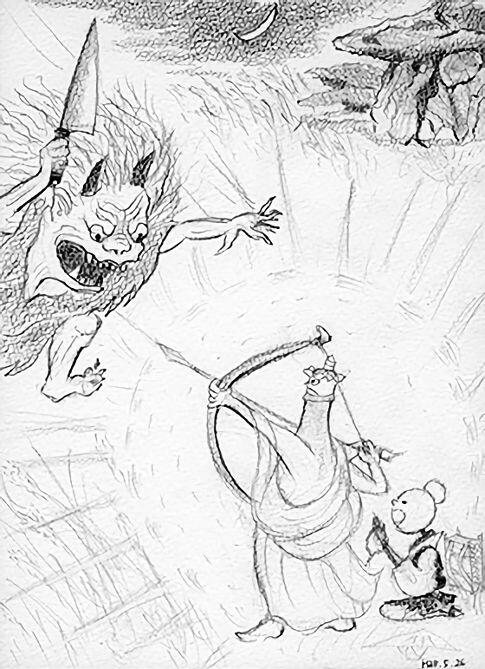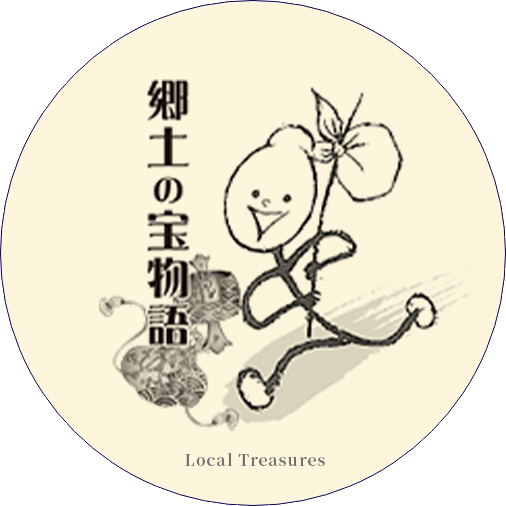(3) The Onibaba Legend of Adachigahara
| Yeast | “In Nihonmatsu there exists a frightening, 1,300 year-old legend. Kimoto, here we are at Kanzeji temple in Adachigahara, famous for the legend of the goblin Onibaba. Huge rocks are lying about, creating just the right atmosphere for the dwelling of Onibaba.” |
|---|---|
| Kimoto | “The legend goes as follows. Long ago, when the sun was about to set, a traveling priest requested to be allowed to stay in a cave for lodging. An old woman lived there, who told him she needed to go outside to get more firewood for the evening meal. She warned the priest that under no condition was he allowed to peep into the back room of the cave. That warning in fact made the priest all the more curious. He stealthily looked into the back room and saw a mountain of human bones piled up inside...” |
| Yeast | (shivering) “Terrible!” |
| Kimoto | “Realizing that this was the abode of the monster Onibaba, the priest ran away as fast as he could. After a while the old woman returned to the cave and realized immediately what had happened. Her looks changed into that of the fearsome Onibaba goblin and she gave chase at a furious speed.” |
 |
|
| Yeast | “Then there was no hope left for the priest!” |
| Kimoto | “The priest pulled out a statue of the Bodhisattva Kannon and started to desperately chant a sutra. As he did so, the Kannon statue flew up into the sky and shot a golden arrow at Onibaba. The goblin was killed. Later it was able to find peace thanks to the guidance of the Buddha.” |
| Yeast | “That was a narrow escape!” |
| Kimoto | “The priest buried Onibaba at the bank of the river Abukuma. On that spot, at the foot of an old pine tree, still stands a marker ‘Kurozuka’ (Black Mound).” |
| Yeast | “That ‘Black Mound’ also appears in a waka poem by Kanemori Taira (d. 991): Is it really true as they say, that in the Black Mound of Adachigahara a goblin lurks?” |
| Kimoto | “You’ve done a lot of research! Do you know the sad story about why the old woman became a goblin?” |
| Yeast | “No, let me hear it.” |
| Kimoto | “In the past, there was a woman called Iwate who served as wet nurse in an aristocratic mansion in Kyoto. However, the young lady whom she cherished had an incurable illness since birth and was unable to speak. Iwate wanted to save the young lady, and believed the words of a fortune-teller who said that the liver from the fetus in the womb of a pregnant woman would be effective against the disease. So she set out on a trip to far-away Mutsu province in Northeastern Japan in order to get that ‘medicine,’ and left her own daughter who had just been born behind.” |
| Yeast | “I don’t believe such ‘medicine’ could work!” |
| Kimoto | “After long years, one evening, a young couple who had lost their way, requested lodging inside the cave. The young woman was pregnant, and just at that moment, started going into labor. The husband went out to buy some medicine. It was the perfect opportunity. Iwate took out a large kitchen knife and assaulted the young woman, cutting the liver out of the fetus.” |
| Yeast | “What a terrible crime!” |
| Kimoto | “However, at that same moment, Iwate caught sight of the protective charm that the young woman had on her. The woman Iwate had just killed was none other than her very own daughter she had left behind in Kyoto! This was such a huge shock that Iwate became mentally unhinged, and turned into the Onibaba goblin who from then on lay in wait to assault travelers.” |
| Yeast | “What a terrible and pitiful legend this is. The story forms the basis for the Noh play ‘Kurozuka,’ and also for the Kabuki and Bunraku plays ‘Adachigahara.’ The shocking scene has also been depicted in ukiyo-e prints.” |
| Kimoto | “The bizarre story has inspired various writers as well. The rock cave in Kanzeji temple in fact looks quite frightful!” |
| Yeast | “But the Onibaba mascot ‘Bappy-chan’ is real cute!” |
| Kimoto | “Nihonmatsu is rich in old and new legends.” |
| Yeast | “Let’s explore more together next time!” |




